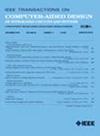HISIM: Analytical Performance Modeling and Design Space Exploration of 2.5D/3D Integration for AI Computing
IF 2.9
3区 计算机科学
Q2 COMPUTER SCIENCE, HARDWARE & ARCHITECTURE
IEEE Transactions on Computer-Aided Design of Integrated Circuits and Systems
Pub Date : 2025-01-17
DOI:10.1109/TCAD.2025.3531348
引用次数: 0
Abstract
Monolithic designs face significant fabrication cost and data movement challenges, especially when executing complex and diverse AI models. Advanced 2.5D/3D packaging promises high bandwidth and connection density to overcome these challenges, yet it also introduces new electro-thermal constraints. This article develops a suite of analytical performance models to enable efficient benchmarking of a 2.5D/3D heterogeneous system for energy-efficient AI computing. These models encompass various performance metrics related to computing units, network-on-chip (NoC), and network-on-package (NoP). The results are summarized into a new tool, HISIM, which isHISIM:面向AI计算的2.5D/3D集成分析性能建模与设计空间探索
单片设计面临着巨大的制造成本和数据移动挑战,特别是在执行复杂和多样化的人工智能模型时。先进的2.5D/3D封装保证了高带宽和连接密度,以克服这些挑战,但它也引入了新的电热限制。本文开发了一套分析性能模型,以实现高效的2.5D/3D异构系统对节能人工智能计算的基准测试。这些模型包含与计算单元、片上网络(NoC)和包上网络(NoP)相关的各种性能指标。结果总结为一种新工具HISIM,它比最先进的人工智能基准工具快10^{4}倍- 10^{6}倍。此外,HISIM集成了2.5D/3D系统的快速热模拟,有助于揭示2.5D/3D异构集成(HI)在代表性AI算法上的潜力和局限性。HISIM的代码可在https://github.com/mec-UMN/HISIM上获得。
本文章由计算机程序翻译,如有差异,请以英文原文为准。
求助全文
约1分钟内获得全文
求助全文
来源期刊
CiteScore
5.60
自引率
13.80%
发文量
500
审稿时长
7 months
期刊介绍:
The purpose of this Transactions is to publish papers of interest to individuals in the area of computer-aided design of integrated circuits and systems composed of analog, digital, mixed-signal, optical, or microwave components. The aids include methods, models, algorithms, and man-machine interfaces for system-level, physical and logical design including: planning, synthesis, partitioning, modeling, simulation, layout, verification, testing, hardware-software co-design and documentation of integrated circuit and system designs of all complexities. Design tools and techniques for evaluating and designing integrated circuits and systems for metrics such as performance, power, reliability, testability, and security are a focus.

 求助内容:
求助内容: 应助结果提醒方式:
应助结果提醒方式:


